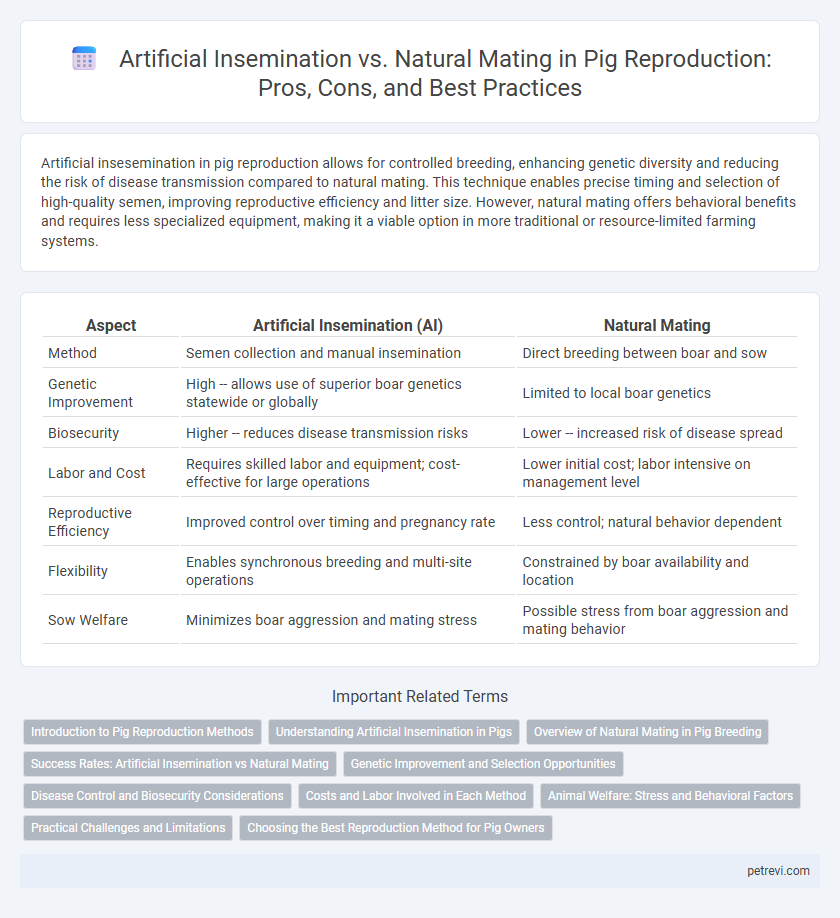Artificial insesemination in pig reproduction allows for controlled breeding, enhancing genetic diversity and reducing the risk of disease transmission compared to natural mating. This technique enables precise timing and selection of high-quality semen, improving reproductive efficiency and litter size. However, natural mating offers behavioral benefits and requires less specialized equipment, making it a viable option in more traditional or resource-limited farming systems.
Table of Comparison
| Aspect | Artificial Insemination (AI) | Natural Mating |
|---|---|---|
| Method | Semen collection and manual insemination | Direct breeding between boar and sow |
| Genetic Improvement | High -- allows use of superior boar genetics statewide or globally | Limited to local boar genetics |
| Biosecurity | Higher -- reduces disease transmission risks | Lower -- increased risk of disease spread |
| Labor and Cost | Requires skilled labor and equipment; cost-effective for large operations | Lower initial cost; labor intensive on management level |
| Reproductive Efficiency | Improved control over timing and pregnancy rate | Less control; natural behavior dependent |
| Flexibility | Enables synchronous breeding and multi-site operations | Constrained by boar availability and location |
| Sow Welfare | Minimizes boar aggression and mating stress | Possible stress from boar aggression and mating behavior |
Introduction to Pig Reproduction Methods
Artificial insemination in pig reproduction allows precise control over genetics, reduces disease transmission, and enhances breeding efficiency by using semen from superior boars. Natural mating relies on physical interaction between the sow and boar, which can limit genetic diversity and increase risk of zoonotic diseases. Both methods have distinct advantages depending on farm management goals and reproductive strategies.
Understanding Artificial Insemination in Pigs
Artificial insemination (AI) in pigs enables precise control over breeding by using semen from genetically superior boars, improving herd genetics and productivity. This technique reduces the risk of disease transmission compared to natural mating and allows for better scheduling of sow inseminations to optimize reproductive efficiency. Understanding AI technology involves knowledge of semen collection, processing, storage, and the timing of insemination based on sow estrus cycles for maximizing conception rates.
Overview of Natural Mating in Pig Breeding
Natural mating in pig breeding involves direct physical interaction between the boar and sow, ensuring natural selection and accurate detection of estrus. This traditional method promotes natural behavioral cues and social interactions, which can enhance reproductive success and piglet viability. While it requires adequate space and boar management, natural mating remains a reliable approach for small to medium-scale pig farms focusing on genetic diversity and robust herd health.
Success Rates: Artificial Insemination vs Natural Mating
Artificial insemination (AI) in pig reproduction often achieves success rates between 70% and 90%, depending on factors such as semen quality, timing, and handling techniques. Natural mating typically yields success rates around 85%, influenced by the boar's fertility and sow receptivity. Optimizing AI protocols can rival or surpass natural mating success, offering controlled genetic improvement and biosecurity advantages in swine breeding programs.
Genetic Improvement and Selection Opportunities
Artificial insemination in pigs enables targeted genetic improvement by allowing the use of superior boars across multiple sows, increasing selection intensity and genetic gain. This method facilitates controlled breeding programs with precise pedigree tracking, enhancing the accuracy of genetic evaluation and trait heritability. In contrast, natural mating limits selection opportunities due to the restricted number of sows a boar can service and less genetic data availability, slowing genetic progress in pig populations.
Disease Control and Biosecurity Considerations
Artificial insemination in pig reproduction significantly reduces the risk of disease transmission by limiting direct contact between animals and minimizing exposure to pathogens commonly spread through natural mating. This method enhances biosecurity by allowing controlled semen collection and screening processes that prevent introduction of infectious agents into the herd. In contrast, natural mating increases the likelihood of spreading sexually transmitted infections and other communicable diseases, posing greater challenges for maintaining herd health and biosecurity protocols.
Costs and Labor Involved in Each Method
Artificial insemination in pig reproduction requires higher initial investment in equipment, semen handling, and skilled labor but reduces ongoing labor intensity through improved scheduling and fewer boars on-site. Natural mating has lower upfront costs but involves continuous labor for boar maintenance, heat detection, and mating supervision, leading to higher long-term labor expenses. Overall, artificial insemination optimizes pig breeding efficiency by lowering cumulative labor costs despite higher operational expenses.
Animal Welfare: Stress and Behavioral Factors
Artificial insemination in pig reproduction reduces stress by minimizing aggressive interactions and handling compared to natural mating, leading to improved animal welfare. Behavioral studies show that AI avoids dominance disputes and mating-related injuries common during natural breeding. Enhanced welfare outcomes through AI contribute to better overall health and productivity in swine herds.
Practical Challenges and Limitations
Artificial insemination in pig reproduction faces practical challenges such as the need for skilled personnel, precise timing of estrus detection, and proper semen storage to maintain viability, which can limit its efficiency. Natural mating allows for direct copulation, but it carries risks like injury to sows, disease transmission, and variability in mating success rates. Both methods encounter limitations related to labor intensity, biosecurity concerns, and reproductive performance consistency in commercial pig farming.
Choosing the Best Reproduction Method for Pig Owners
Artificial insemination in pig reproduction offers enhanced genetic selection, improved disease control, and increased efficiency compared to natural mating. Natural mating, while simpler and less labor-intensive, may limit access to superior genetics and elevate risks of transmitting reproductive diseases. Pig owners should evaluate herd management goals, genetic improvement priorities, and biosecurity measures when deciding between artificial insemination and natural mating methods.
Artificial insemination vs Natural mating for Pig reproduction Infographic

 petrevi.com
petrevi.com